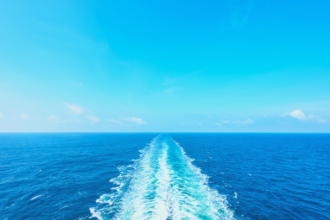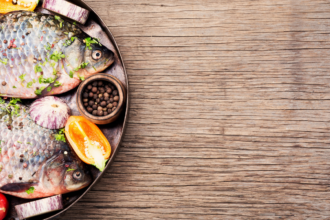The pressing need for a sustainable diet – can fish be in the answer?
Latin: Fame, (Classical) IPA (key): /ˈfa.meːs/, [ˈfämeːs̠]
English: Hunger
The thought of feeding humankind in the future, torments experts, businesses, as well as curious and worried minds. Thousands of studies gravitate around the global population growth and the unquestionable realities of climatic changes and sustainability, undermined by over explored natural resources. Why only now has hunger become a hot topic, while developing countries have struggled for basic survival resources since eras before? Because the hunger theme and its gravitating topics have now knocked at our privileged doors – it’s no longer someone else’s challenge, it is now a single voice and a single population.
Humans have a food problem. Approximately 1.3 billion tonnes (one third) of all food produced is lost or wasted costing the global economy nearly $940 billion (approximately 790 billion €) each year and contributing to 8% of greenhouse gas emissions.[i] There is no doubt that this is a multifactorial problem: high numbers of people are hungry; large nutritional imbalances remain to this date between high- and low-income nations and regions; paradoxically, even within high-income nations, poor nutrition is a worrying reality due to the consumption of highly processed foods; and the entire food value chain is failing both society and harming the planet.
Why aquaculture fish is a key protein global supplier
Let me be clear: this is an article that unapologetically advocates for the introduction of fish protein consumption through aquaculture as a strong candidate to support the development of a sustainable global menu. Currently, fish supports more than 4,5 billion consumers with at least 15% of their average per capita intake of animal protein.
Why aquaculture? Because it has the potential to run under sustainable practices and respond to the pressing need of providing high amount and highly nutritious food to support a growing population.
To which extent can we indiscriminately consume without unbalancing the scales of Nature itself? Can we compromise to the point where we can tip the scales back to reasonability and follow a suitable global menu? There is no question that a change in the consumption paradigm is intimidating and an understudied challenge. The COVID-19 pandemic has re-enforced these issues into daylight and exacerbated them. And there is no doubt that the political, economic, and cultural obstacles have been prolific on hampering and delaying the way to achieve a sustainable global menu. Paradoxically, in the middle of a turmoil of contradictions that our society is based on, the nouvelle vague of healthy products, local and sustainable choices have become an almost hipster way of living (but only for some). Hipster or otherwise, this is the way forward: think beyond ourselves and beyond the immediate satisfaction of our over indulged cravings and established societal ways of living. To succeed, we need to look for new, better, sustainable ways to force our societal matrix and habits into renewal.
Since the Industrial Revolution, human diets evolved towards an increased consumption of animal products. This demand is no longer a trend but rather an installed way of living to the point in which it is expected to be much higher in the coming decades, with most of this growth taking place in developing countries[ii].
Aquaculture plays a relevant role in fulfilling the need for animal protein, ramping up to overtake wild fish stocks as the main source of dietary aquatic protein by 2050[iii]. Non-aquatic animal production occupies, directly or indirectly, about 75% of all arable soil and consumes about 8% of the drinking water used by man [i],[iv]. The world production of compound feeds for animal production accompanies the progressive increase in the consumption of animal products, having reached about 1 billion metric tons in 2015, 1.5% higher than 2014. According to FAO1, this production needs to increase by around 70% to feed the world in 2050.
Farming fish for consumption exists since approximately 2000 B.C. and has been simmering since then as a way of introducing animal protein and replacing consumption of land-based animal protein. In fact, in many areas across developing regions such as Africa, aquaculture has been a live safer, as the main provider of animal protein. In regions like these, aquaculture has greatly impacted the economy of local communities by providing employment with steady income while sustaining the food requirements of a growing population[v].
The new paradigm: feeding a growing world population while respecting Nature
The pressure on the food sectors to maximize production while reducing waste is an installed new paradigm that has derived from the UN estimates that the global population is expected to reach 9 billion by 2050. Not only do food sectors need to galvanize themselves to fulfil demand, but they also need to do so in a sustainable way and in a scenario where key resources such as land and water are likely to be scarcer and where the climate change will growingly impact. The sector of fish production is no exception. We need to further bring aquaculture technology into this new age of improved food security and sustainability – make no mistake, environmental challenges associated with aquaculture persist, including destruction of marine habitats, use of harmful chemicals and veterinary drugs, and the production of waste[vi]. In Europe we have, however, come a long way in tightly regulating the use of chemicals and reducing environmental impact. We have had some bad actors, who have done the wrong things and, frankly, broken the rules, says Martin Excel, managing director of Seafood Business for Ocean Stewardship.The reader might be confused at this point. Aquaculture is not one of the solutions to hunger after all? Yes, it is, despite the challenges. Sustainability-wise, fish is one of the most efficient converters of feed into a high-quality and nutritious food with a carbon footprint that is significantly lower than other animal production systems.
Fish is a must when drawing the strategy for a global sustainable menu.
Although technology has led to advancements in developing better techniques to increase fish farming4, to say that we have now reached a state of “blue revolution” might be an over statement. Still, it is interesting that every second fish we consume is from aquaculture, having contributed to the global supply of fish that has grown by a factor of 8 since 19502. The modern farmed seafood industry is relatively young and despite the bad reputation that comes with it, aquaculture has experienced a tremendous development ranging from animal welfare, veterinary approach, sustainable and intelligent infrastructure, etc. Fish farming is booming its development towards a positive impact in its surroundings – environmentally friendly practices, local jobs creation and supporting the growing need for sustainable sources of food. In fact, according to Peter Thomson, the UN Secretary-General’s Special Envoy for the Ocean, through the development of new forms of sustainable aquaculture with appropriate species and feeds, mariculture (the farming of organisms in marine environments), shellfish farming, and much greater attention to macroalgae (seaweed) for human and animal food, the Ocean will provide us with a large proportion of the nutritious food we need[vii]. Moreover, since not only fish, but all seafood, has a fairly low carbon footprint when matched against land-based agriculture, aquaculture has an enormous potential to have a positive role in supporting the achievement of the Sustainable Development Goal 13, which encompasses urgent action to combat climate change, and its impacts.
Under the UN Global Compact initiative, in 2020 a roundtable of seafood industry CEOs, convened by the agency, highlighted the key role seafood can play in feeding a growing world population, and recommended aquaculture to be an incorporated part of a sustainable future food system.
Aquaculture is no longer at its infancy, it is rather at the verge of becoming a force to be reckon with as having a tremendous potential to guarantee that seafood, namely fish, becomes a stronger contributor for a sustainable menu. This is the era of smart investments and technological advancements. It is the era of adaptation – we, as humankind, need to adapt or otherwise face an even more challenging future.
Maybe we need to take a moment and revisit Darwin’s words: It is not the strongest of the species that survives, it is the one that is the most adaptable to change.
References
1. https://www.ozharvest.org/sustainability/food-waste-facts/
2. FAO, 2009
3. Sustainable nutrition, Nature | Vol 588 | 10 December 2020
5. Is Aquaculture the Answer to World Hunger? I Bioenergy Consult, by Emily Folk | April 13, 2020
6. Wenche Grønbrekk is the chairperson of the United Nations Global Compact Local Network for Norway, a group of private companies that have agree to work towards the UN’s Sustainable Development Goals (SDGs).
7. A deep dive into Zero Hunger: farming the seas. UN News – Global perspective Human stories I15 November 2020





